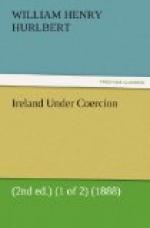There is nothing froward or formidable in the aspect of Dublin Castle. It has neither a portcullis nor a drawbridge. People go in and out of it as freely as through the City Hall in New York. There is a show of sentries at the main entrance, and in one of the courts this morning the picturesque band of a Scotch regiment was playing to the delectation of a small but select audience of urchins and little girls. A Dublin mob, never so little in earnest and led by a dozen really determined men, ought to be able to make as short work of it as the hordes of the Faubourgs in Paris made of the Bastille, with its handful of invalids, on that memorable 14th of July, about which so many lies have passed into history, and so much effervescent nonsense is still annually talked and printed.
The greater part of the Castle as it existed when the Irish Parliaments sat there under Elizabeth, and just before the last Catholic Viceroy made Protestantism penal, and planned the transformation of Ireland into a French province, was burned in the time of James II. The Earl of Arran then reported to his father that “the king had lost nothing but six barrels of gunpowder, and the worst castle in the worst situation in Christendom.”
Here, as at Ottawa, a viceregal dinner-table is set off by the neat uniforms and skyblue facings of the aides-de-camp and secretaries. For some mysterious reason Lord Spencer put these officers into chocolate coats with white facings. But the new order soon gave place to the old again.
At the dinner to-night was Lord Ormonde, who is returning to London, but kindly promised to make arrangements for showing me at Kilkenny Castle the muniment room of the Butlers, which contains one of the most valuable private collections of charters and State papers in the realm.
Tuesday, Jan. 31.—I lunched to-day with Sir Michael Morris, the Lord Chief Justice of Ireland, whom I had last seen in Rome at the Jubilee Mass of His Holiness. Sir Michael is one of the recognised lights of social life and of the law in Dublin. While he was in Rome some one highly commended him in the presence of that staunch Nationalist the Archbishop of Dublin, who assented so far as to say, “Yes, yes, there are worse fellows in Dublin than that Morris!” It would be hard to find a more typical Irishman of the better sort than Sir Michael, a man more sure, in the words of Sheridan, to “carry his honour and his brogue unstained to the grave.”
The brogue of Sir Michael, it is said, made his fortune in the House of Commons. It has hardly the glow which made the brogue of Father Burke a memory as of music in the ears of all who heard it, and differs from that miraculous gift of the tongue as a ripe wine of Bordeaux differs from a ripe wine of Burgundy. But to the ordinary brogue of the street and the stage, it is as is a Brane Mouton Rothschild of 1868 to the casual Medoc of a Parisian restaurant. “Do you know Father Healy?” said one of the company to whom I spoke of it; “he was at a wedding with Sir Michael. As the happy pair drove off under the usual shower of rice and old slippers, Sir Michael said to the Father, ’How I wish I had something to throw after her!’ ‘Ah, throw your brogue after her,’ replied the Father.”




